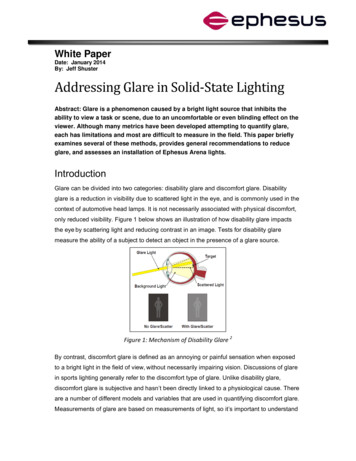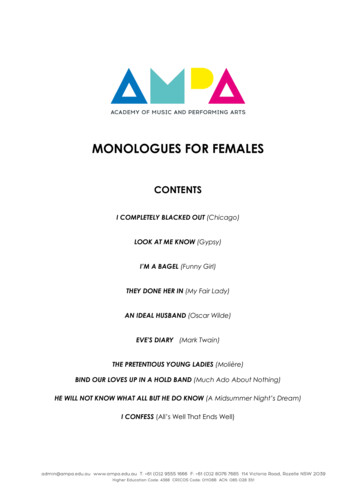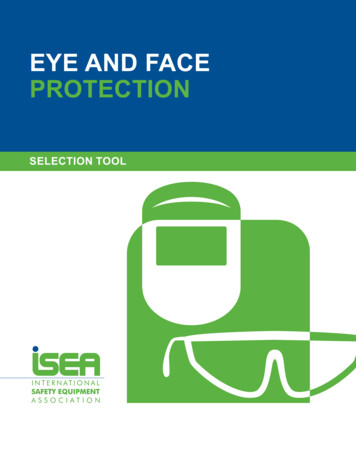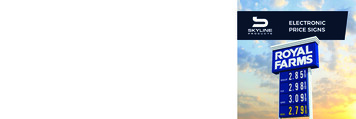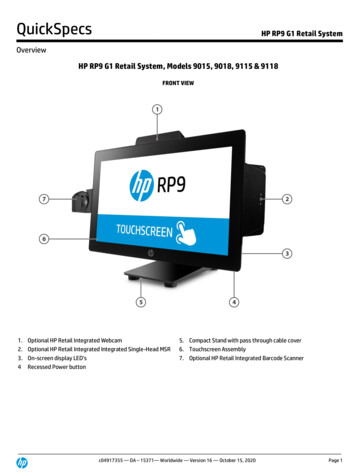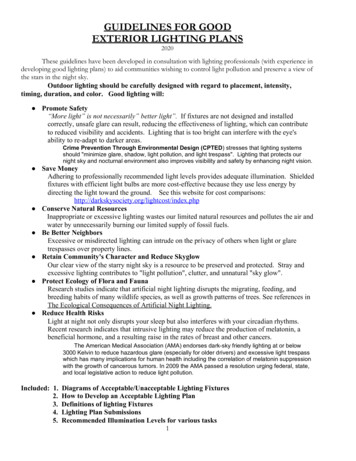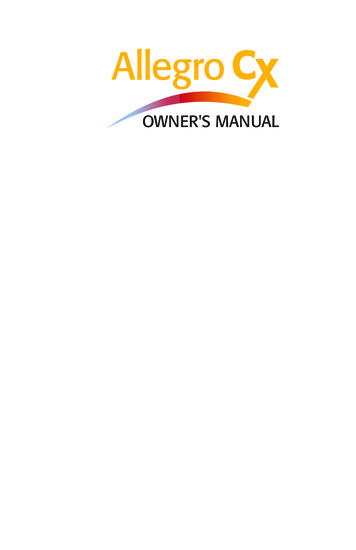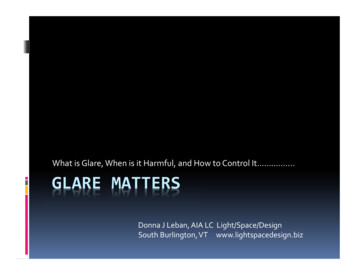
Transcription
What is Glare, When is it Harmful, and How to Control It .GLARE MATTERSDonna J Leban, AIA LC Light/Space/DesignSouth Burlington, VT www.lightspacedesign.biz
Contents§ What Constitutes Glare?§ How do Ambient Lighting Conditions affectour Glare Perception?§ How do you know if a luminaire or lamp willbe perceived as having unacceptable glare?§ Methods for Controlling Glare from ElectricLight Sources§ Dimming Light Sources to Reduce Glare
Definition§ Glare, def. RPI Lighting Research Center. Glareis a visual sensation caused by excessive anduncontrolled brightness.§ It can be disabling or simply uncomfortable.§ It is subjective, and varies widely§ Characteristics of the Aging Eye give olderindividuals more problems with glare.
Glare and the Aging Eye§ Changes in the eye aswe age (50 ) include:ú Intraocular lightscatteringLoss of visual contrastú Glare sensitivityBlinking or SquintingFatigueú Photostress recoverytimeú Narrowing field of vision
Types of Glare§ Discomfort Glare: Thesensation ofannoyance and evenpain caused by overlybright sources. (Rea,2000)§ Disability Glare:Reduction in visibilitycaused by intense lightsources in the field ofview.Photo credit- Lighting Research Center, and Lumec
Disability Glare in Night Driving“Visual skills are pushed to their limit at night by decreased illumination and bydisabling glare from oncoming headlights.” British Journal of Opthalmology
Disability Glare Types§ Dazzle- Intense, smallglare source directedtoward viewerú Poorly Aimed Outdoorflood lightsú Oncoming vehicleheadlightsú Stage lights§ Scotomatic- photostressú Flash photographyleaves afterimagesTransient sources of glare areworse than static sources
Disability Glare types§ Veiling – Brightuniform & diffuse lightsource reduces visualcontrastú Reading in brightsunlightú Seeing an objectbetween two brightly litwindows
Daylighting is a Source of Glare§ Luminance: Range ofIlluminance (fc) of:visual tolerance§ Starlight 0.0002 fcú Sun on Clear Day Noon§ Full Moon 0.025 fc1,600,000,000 cd/m2ú 10,000 fc§ Overcast Sunrise/set 4 fc§ Clear Sky Sunrise/set 40 fc§ Overcast Noon Sky 200 fc§ Clear Sky in Shade 2000 fc§ Clear Sky Noon 10,000 fc
Discomfort Glare: Annoying but notDisabling§ Too much Light§ Size of the Glare source§ Position of the sourcein the Field of View§ Excessive Contrastcompared tobackground luminance
Discomfort Glare: Counterproductiveand sometimes harmful in the Workplace§ Loss of Productivity§ Headaches§ Loss of Work TimeToo much light- direct orreflected causes eye strain
Discomfort Glare and Visual Contrast§ The eye can adapt to a widerange of Luminance(Brightness), but not at thesame time!Best office lightinghas relatively lowcontrast with goodtask brightness.
When is Glare Desirable?§ Entertainment Ltg§ Retail and attractionswhere lighting is partof the actWhat is the differencebetween sparkle andglare?
Difference: Glare vs Light Trespass§ Light trespass is aboutlight projected where itis not wantedú Measured in footcandles§ Glare is about theintensity of the lightsource directed towardan observers eye
Glare Control and Preventionis Good Lighting Practice§ Adaptation to AverageScene Luminancecomposed of:§ Ranges fromú 0.001 fc – starlightú 10,000 fc- sunny dayú Task LuminanceSelf Illuminated TasksTask ReflectanceúúúúBackground LuminanceLight Source LuminanceLight PatternsLight Gradients§ The eye can only adaptto part of this range ata time.ú Abrupt changes causetemporary glare untileye adapts.
Practical guideline§ Glare is typical whenunshielded light is 1000times brighter thanaverage visual field.ú Night conditionsú Officeú Retail§ Candela meter tomeasure candelas/m2§ Digital camera autoadjusts to average Lum.
Practical Measurement of Glare§ In retrofit- comparewith existing sources§ Looking at a luminaireon a table is not thesame as viewing it inplace.
Why Exterior Glare is a Problem§ Can’t Balance OutdoorLuminance§ Light Emitting Diodesare point sourcesú Very high lumen outputfrom a small sourceú Continued gains inefficacy (lumens/watt)ú Mfrs cutting fixturecosts by using fewer,higher output LEDs
Understanding Glare from Data§ IESNA TM-15-07Rating of OutdoorLuminaires§ B-U-G Ratingú Backlight – relates toInternational Dark Sky Associationand Illuminating EngineeringSociety of North Americalight trespassú Uplight- relates to skyglow, unusable lightú Glare- in the 60-90 range of lumen output
Outdoor Glare Measurements§ CIE doc#112-1994, GlareRating (GR)- calculatedfor outdoor lighting fromone observer position§ LRC, Discomfort Glare(DG)- empirical modelrated by subjects on aDeBoer scaleú Based on Veilingú Glare strongly related toluminance summed acrossluminaires, and the angleof sight vs direction oflighting.ú Resulting scale 10 to 90ú 90 is unbearableú Function in lightingsoftwareilluminance for smalleroutdoor light sources.ú Based on source illuminance, source luminance,and surrounding andambient illuminance.ú 1 is unbearable, 9 is best.
Measuring Interior Glare§ UCR- Uniform GlareRating (CIE Publication#117-1995) an indexranked on a scale 5 to40.§ UCR is included inmajor ltg software§ Includes:ú Background luminanceú Luminaire luminance(sum of all)ú Angle of the source fromviewer’s positionú Viewer’s Position Index
Uniform Glare RatingUGRDiscomfortGlare Criterion10Imperceptible13Just perceptible16Perceptible19Just ceptable
Room Simulation of UGRSimulation:1. 85/40/20 reflectance and full output 4688 lumenLED direct/indirect at 49w, Avg fc 52UGR Range 23 to 10, Avg 18
Hallway Simulation of UGRSimulation:1. 80/50/20 reflectance at 675 lumens, LED surfacedirect at 13w, Avg fc 11UGR Range 22 to 18
3 Methods of Controlling Glare1. Shield the light sourcefrom view2. Enlarge and Diffusethe light source toreduce luminance3. Balance roomluminanceú Dim the lamp/luminaireú Add daylightú Lighten walls, floors,ceilings
1. Shielding the Light Source§ Light “spillage” is aproperty of a luminairedesign.ú Shades, reflectors,louvers, or refractivelensing project light in acontrolled directionú Reduces glare whenviewed outsideprojected area
Where Shielding is Most Needed§ Retail lightingú Glare distracts fromproduct display§ Work environmentsú Long hours under glareylights can cause eyestrain and headaches§ Health Careú Healing space requireslighting designed forcomfort
Shielding of Outdoor Light Sources“Cutoff” Shielding and Highangle brightness control arecritical for outdoor luminaires.Parking garage ltg should alsoilluminate ceiling surface.
2. Diffuse the Light Source§ Particularly importantwith directional LEDlight source§ Improved lens optionsdiffuse appearance ofindividual diodes§ Size and brightness ofluminous area incontrast to adjacentroom surfaces (UGR)
Back Light and Edge Light Diffusion§ Lenses mounted toindividual LED package§ Acrylic laminate sheetdiffusers typical of LEDbacklight applications§ Proprietary materialsrefract LED edge light
When Choosing LED Troffer Options§ LED Luminaires (HiE)ú Indirect Relationship ofúúúúCost and GlareAvoid pixelationA Larger illuminatedsurface area is betterLower surfaceluminance is betterReduce contrast withceiling for best results§ LEDT8 Lampsú Best with openluminairesú Always test luminaireapplication with existingballasts (UL approval)
Comparing Shielding and Diffusion inFluorescent & LED Luminaires
Comparing Fluorescent and LED Fixtures
Control Luminaire Brightness§ Edge Light LED Trofferreduces surface brightness and UGRSimulation:2. 90/60/30 reflectanceand full output 4452 lumen LED surface edgelit luminaireat 47w, Avg fc 34UGR Range 18 to 10, Avg 14 (just perceptible)
3. Balance Room Luminance§ High reflectance, mattfinish walls, ceiling,floors§ Control light sourcesurface luminance§ Reduce contrast withadditional light source§ Controlled use ofdaylight
Controlling Luminance§ For office work inparticular- BalanceRoom SurfaceLuminance with TaskLuminance.§ If computer screenluminance is 100 cd/m2then the brightestsurface should be 1000 cd/m2 and thedarkest 10 cd/m2.
Control Luminaire Brightness andIncrease Wall Luminance§ True recessed LED downlightconceals light source, uses lowglare reflector§ Moving fixtures closer to wallincreases wall luminanceSimulation:80/50/20 reflectance with 685 lumens @ 12weach, UGR of 10 (imperceptible glare)
3c. Controlling Luminance by Dimming§ Besides controllingglare, why dim?ú Maximize energy savedú Extend system lifeú Enhance flexibilityú Increase productivityú Enhance ambienceú Provide comfort
Dimming: LED lamps or LED fixtures?§ Lamp Dimmingú If options are limited toLED lamps, controloptions will also belimited.Screw Base Lamp basecontains an integral driverSize of components andcosts pose limitsMost designed for typicalincandescent dimmersMost work better ondimmers designed for LED
What type of Control or Control Systemcan be used with LED Lamps?§ For Single Room andRetrofit Applicationsú Reverse Phase PWMú Forward Phase PWMú 0-10v Wired or Wireless§ Wifi Controlsú Control of individuallamps
What is the Dimming Range?§ Dimming range isbased on the driver§ Example: For aconference room, 5%dimming or lower maybe required.§ Solution: Specifyfixtures with driversthat dim to 5% (1%available), and acompatible dimmerwith low end setpoint.
What is the Dimming Performance?§ Dimming performanceis mainly a function ofthe driver, although acompatible controlleris needed to realizeflicker-free, smoothand continuousdimming.§ Driver Typesú Pulse Width ModulationRapid on/off switching ofthe current to the LED’sFlicker can be an issuewhen dimmed to low levelú Constant CurrentReductionReduces the amount ofcurrent delivered withoutturning it on/off.Best dimming
Factors Determining Flicker in Dimming1. Peak light output vsminimum light outputin a cycle2. Difference betweenPeak and Minimumlight output3. Shape of the lightoutput in a cycle4. Frequency
How many LED Lamps can be Connected toOne Dimmer?§ LED lamps often havea high startup inrushcurrentú A 15w rated LED lampmay have the inrushcurrent equivalent to a60w incandescent lamp.ú (1) 600w dimmer candim only (10) 15w lamps.ú (1) 600w dimmer per(30) 5w candelabra base.How would you dim this whenusing LED candelabra lamps?
Is there a Minimum Load Required by aLV Transformer or Dimmer?§ If a dimmer requires25w minimum load,you may need 4 or 5LED lamps to meet it§ Low voltage halogentrack heads often notcompatible w/ LED
Better Options for LED Fixture Dimming§ Dimming luminaires withLED driversú Dimming is a function ofthe type of power supplyú Not all LED drivers aredimmableú Dimming Power suppliesPulse Width Modulation(Phase Cut Dimming)Constant Current Reductionú Control Method isseparate and distinct fromdimming type
Dimmer or Control System Options forDimming LED DriverLED drivers§ Low voltage dimmingcontrols operated byDimmingDriverú LV Dimming switchú LV Dimming Panelú LV Control network§ Digital drivers dim withdigital addressablenetwork controlsLow voltagedimmer switchWirelesslow-voltagecontroller
Recap: 3 Methods for Controlling Glare1. Shield the light sourcefrom view2. Enlarge and Diffusethe light source toreduce luminance3. Balance roomluminanceú Dim the lamp/luminaireú Lighten walls, floors,ceilings
Can you nowanswer thesequestions?What Constitutes Glare?How do Ambient Lighting Conditions affect ourGlare Perception?How do you measure glare?What are Methods of Controlling Glare fromElectric Light Sources?How do you dim LEDS that cause Glare?
Definition §Glare, def. RPI Lighting Research Center.Glare is a visual sensation caused by excessive and uncontrolled brightness. §It can be disabling or simply uncomfortable. §It is subjective, and varies widely §Characteristics of the A
